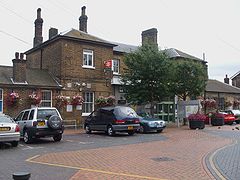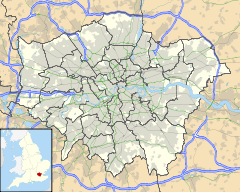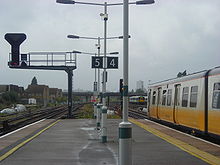- Norwood Junction railway station
-
Norwood Junction 

Location of Norwood Junction in Greater LondonLocation South Norwood Local authority London Borough of Croydon Managed by London Overground Owner Network Rail Station code NWD Number of platforms 5 (7 in total) Fare zone 4 National Rail annual entry and exit 2004-05  1.792 million[1]
1.792 million[1]2005-06  1.829 million[1]
1.829 million[1]2006-07  2.946 million[1]
2.946 million[1]2007-08  3.040 million[1]
3.040 million[1]2008-09  2.846 million[1]
2.846 million[1]5 June 1839 Opened (Jolly Sailor) October 1846 Renamed (Norwood) 1 June 1859 Resited 1 October 1910 Renamed (Norwood Junction and South Norwood for Woodside) 13 June 1955 Renamed (Norwood Junction)[2] List of stations Underground · National Rail External links Departures • Layout Facilities • Buses Coordinates: 51°23′50″N 0°04′30″W / 51.3972°N 0.075°W
Norwood Junction railway station is in South Norwood in the London Borough of Croydon in south London, in Travelcard Zone 4.
The station is managed by London Overground and trains operated by Southern and London Overground (since May 23, 2010).
Contents
History
The station at Norwood has occupied two sites and been known by three different names during its history.
‘’Jolly-sailor’’ and ‘’Norwood’’ stations
 Jolly-sailor station in 1845, showing the bridge carrying Portland Road in the background and the atmospheric-propulsion system pumping station, with its Gothic chimney/exhaust vent, in the foreground.[3]
Jolly-sailor station in 1845, showing the bridge carrying Portland Road in the background and the atmospheric-propulsion system pumping station, with its Gothic chimney/exhaust vent, in the foreground.[3]
In 1839 the London and Croydon Railway opened Jolly-sailor station (sic) — listed as "Jolly-sailor near Beulah Spa" on fares lists and timetables — at the north end of the High Street. The station was immediately adjacent to a level crossing over Portland Road. From 1841 the lines through Norwood were used by the London and Brighton Railway and from 1842 the South Eastern Railway but neither of these companies used the station.
In 1844 the London and Croydon Railway was given parliamentary authority to test an experimental pneumatic propulsion system on the railway (referred to at the time as the atmospheric-propulsion system). A pumping station was built on Portland Road to create a vacuum in a continuous pipe located centrally between the rails. A piston extended downwards from the trains into a slit in the pipe, meaning that trains were literally sucked towards the pumping station (or more accurately, blown away from it by atmospheric pressure). The pumping station was built in a Gothic style, with a very tall ornate tower which served both as a chimney and as an exhaust vent for air pumped from the propulsion pipe.
As part of the construction works for the atmospheric-propulsion system, the world's first railway flyover (overpass) was constructed beyond the south end of the station to carry the new atmospheric-propulsion line over the conventional London & Brighton Railway steam line below.[4]
In July 1846 the London and Croydon Railway merged with the London and Brighton Railway to form the London Brighton and South Coast Railway, and the station was renamed ‘’Norwood’’ in the same year (but had become ‘’Norwood Junction’’ by 1856). The new company abandoned the atmospheric propulsion experiment in 1847 but the flyover remains in use as part of what is sometimes known as Windmill Bridge Junction.
Norwood Junction station
Following construction of new lines to Crystal Palace the original station was closed on 1 June 1859 and replaced by the current station on the south side of the A215 road. The station building was used as a private house until the 1960s when it was demolished.
Norwood Junction rail accident
The Norwood Junction railway crash occurred on 1 May 1891, when a cast iron under-bridge fractured under an express train from Brighton to London in southern England.
Connection to Sherlock Holmes
It is from this station that the villain Jonas Oldacre takes his train to London Bridge in the Sherlock Holmes story The Adventure of the Norwood Builder.[5]
Facilities
There are seven platforms but at the present time only five of them are in use.
Platforms 1 & 2
Platform 1 is the first platform when entering the station via the main entrance. This is the only platform which disabled users can use at the moment without having to negotiate the subway via stairs. Its main use is for trains travelling northwards to Highbury & Islington, London Bridge and London Victoria; most of these trains are slow serving many Southern stations. The services mainly come from Caterham and Sutton.
Platform 2 shares the same track as Platform 1 but passengers are not able to join or alight from platform 2 as the doors open only on the Platform 1 side.
Platform 3
Platform 3 is for faster services to London Bridge. It is also the only northwards platform served by Southern train services from Tonbridge. Most services come from Horsham, East Grinstead and Reigate, with the occasional service from Brighton and Uckfield. Once the Thameslink Programme is complete, First Capital Connect services to Bedford will stop at this platform as well.[citation needed]
Platforms 4, 5 & 6
Platforms 4, 5 and 6 are for southwards services, with all trains serving either West Croydon or East Croydon. Platform 4 is for fast services from London Bridge to Uckfield, East Grinstead, Gatwick Airport, Tonbridge, Tattenham Corner and Horsham. Platform 5 is for Metro services within London that have stopped at a few stations on their way, mainly involving high-frequency London Bridge services to Sutton and Caterham. Platform 6 is usually just used when platform alterations are required. Services to Smitham coming from London Victoria via Crystal Palace are usually scheduled to stop at Platform 5 but can sometimes be subject to a platform alteration to Platform 6.
Platform 7
Platform 7 is disused at the moment and the line is covered by overgrown plants.
Typical service
Typical off-peak service is as follows, in trains per hour (tph):
Up (northbound)
- 6 to London Bridge, of which two call at all stations, two stop only at New Cross Gate, and two run fast to London Bridge
- 4 to Highbury & Islington via Canada Water
- 2 to London Bridge via Crystal Palace, East Dulwich and Peckham Rye
- 2 to London Victoria via Crystal Palace and Clapham Junction
Down (southbound)
- 6 to West Croydon
- 2 to Caterham via East Croydon
- 2 to Coulsdon Town via East Croydon
- 2 to Sutton via West Croydon
- 1 to Horsham via East Croydon
- 1 to Tonbridge via East Croydon
Preceding station  National Rail
National RailFollowing station Anerley Southern
Brighton Main LineEast Croydon Crystal Palace Southern
London Victoria to Sutton via Crystal PalaceWest Croydon London Bridge or New Cross Gate Southern
London Bridge to Tonbridge / Horsham
(via Redhill and East Croydon)East Croydon Preceding station 
 London Overground
London OvergroundFollowing station Anerley
towards Highbury & IslingtonEast London Line West Croydon
TerminusFuture
London Overground
The London Overground network extended the East London Line to West Croydon via Norwood Junction which fully opened on the 23rd May 2010. The project was to be finished by June 2010. The link connects Norwood Junction with Dalston Junction and Highbury & Islington in North London for interchange with First Capital Connect and the Victoria Line.
As a result of London Overground routes being shown on the iconic London Tube map, Norwood Junction now appears on some versions of the standard tube map introduced in January 2008 (shown as part of the 'under construction' portion of the London Overground). However these services remain part of the National Rail network and national fares will still be able to be purchased (unlike from Underground stations)
Thameslink Programme
The Thameslink Programme (formerly known as Thameslink 2000), is a £3.5 billion major project to expand the Thameslink network from 51 to 172 stations[6] spreading northwards to Bedford, Peterborough, Cambridge and King's Lynn and southwards to Guildford, Eastbourne, Horsham, Hove to Littlehampton, East Grinstead, Ashford and Dartford. The project includes the lengthening of platforms, station remodelling, new railway infrastructure (e.g. viaduct) and additional rolling stock. When implemented, First Capital Connect services would also call at Norwood Junction station.
Marshalling Yard
The LB&SCR constructed a large freight marshalling yard to the south of the station during the 1870s, which was extended in the early 1880s.[7] With the dwindling freight traffic the marshalling yard fell into disuse by the 1980s and the tracks were relaid to accommodate an enlarged Selhurst Carriage Depot.
Motive Power Depot
The Southern Railway opened a 5-road motive power depot with a 65 ft (19.8 metre) turntable in 1935, to serve the local marshalling yard. It replaced an earlier engine shed at West Croydon. This depot was closed in 1964 and demolised in 1966.[8]
Transport Connections
Norwood Junction is well served by bus routes, with three bus stops including two bus stands available close by. On the Portland Road side are two bus stops for routes 197 (Croydon-Peckham) and 312 (South Croydon–Norwood Junction). The High Street 'Clocktower' bus stop serves routes 75 (Croydon–Lewisham), 157 (Morden–Crystal Palace) and 410 (Wallington–Crystal Palace). The Grosvenor Road bus stop serves two routes, 130 (New Addington–Norwood Junction) and 196 (Norwood Junction–Elephant and Castle).
Route 75 was formerly a 24 hour route but the service was withdrawn in favour of a higher frequency of buses on a Sunday[citation needed] by Selkent when they took the service over from Stagecoach London. Metrobus won the contract from April 2009 and works the route from their Croydon garage. However a bus stop on Night Bus route N68[9] is located half a mile away on White Horse Lane. Other service operators are Arriva London, Abellio and Metrobus.
References
- ^ a b c d e "Station usage". Rail statistics. Office of Rail Regulation. 30 April 2010. http://www.rail-reg.gov.uk/server/show/nav.1529. Retrieved 17 January 2011. Please note: Some methodology may vary year on year.
- ^ Butt, R.V.J. (1995). The Directory of Railway Stations, Patrick Stephens Ltd, Sparkford, ISBN 1-85260-508-1, p. 175.
- ^ "Jolly-sailor Station". The Pictorial Times. 1845.
- ^ Connor, J.E. (2006). London's Disused Stations: The London Brighton & South Coast Railway. Colchester: Connor & Butler. p. 70. ISBN 978 0 947699 39 2.
- ^ Duncan, Alistair (2009). Close to Holmes: A Look at the Connections Between Historical London, Sherlock Holmes and Sir Arthur Conan Doyle. London: MX Publishing. ISBN 1904312500.
- ^ "Good news for South London as £3.5BN Thameslink project clears major hurdle" (Press release). 2006-10-18. http://www.networkrailmediacentre.co.uk/Content/Detail.asp?ReleaseID=2413&NewsAreaID=2&SearchCategoryID=8. Retrieved 2007-04-12.
- ^ Turner, John Howard (1979). The London Brighton and South Coast Railway 3 Completion and Maturity. Batsford. ISBN 0-7134-13819-1. p.76.
- ^ Hawkins, Chris and Reeves, George. (1979). An historical survey of Southern sheds. Oxford Publishing Co.. ISBN 0-86093-020-3. p.60.
- ^ "Bus Route N68". Transport for London. http://www.tfl.gov.uk/tfl/gettingaround/maps/buses/?route=N68. Retrieved 2007-04-12.
External links
- Train times and station information for Norwood Junction railway station from National Rail
Buildings and structures in Croydon Highrises 100 George Street · Altitude 25 · Apollo House (Croydon) · Central One · Cherry Orchard Road Towers · Croydon Tower · Croydon transmitting station · Croydon Vocational Tower · Direct Line House · IYLO · Lunar House · Nestlé Tower · No.1 Croydon · Prudential House · Ruskin Square · Saffron Square · Taberner House · Wettern House
Notable lowrises Addington Palace · Airport House · Ashcroft Theatre · Bridge House · BRIT School · Croydon College · Croydon Clocktower (David Lean Cinema • Museum of Croydon • Croydon Central Library) · Cane Hill · Old Palace · Croydon Minster · Fairfield Halls · Grants · John Ruskin College · Croydon University Hospital · RAF Kenley · Ruskin House · Safari Cinema · The Exchange · Trinity School of John Whitgift · Warehouse Theatre
Major railway stations East Croydon · Norwood Junction · Purley · West Croydon
Major complexes Sports venues Croydon Arena · Croydon Sports Arena · Croydon Water Palace · Selhurst Park
London Overground Current routes Anerley · Brockley
· Brockley  · Canada Water
· Canada Water  · Canonbury · Crystal Palace
· Canonbury · Crystal Palace  · Dalston Junction · Forest Hill
· Dalston Junction · Forest Hill  · Haggerston · Highbury & Islington
· Haggerston · Highbury & Islington 
 · Honor Oak Park
· Honor Oak Park  · Hoxton · New Cross
· Hoxton · New Cross  · New Cross Gate
· New Cross Gate  · Norwood Junction
· Norwood Junction  · Penge West
· Penge West  · Rotherhithe · Shadwell
· Rotherhithe · Shadwell  · Shoreditch High Street · Surrey Quays · Sydenham
· Shoreditch High Street · Surrey Quays · Sydenham  · Wapping · West Croydon
· Wapping · West Croydon 
 ·
·
Whitechapel Acton Central · Brondesbury · Brondesbury Park · Caledonian Road & Barnsbury · Camden Road · Canonbury · Dalston Kingsland · Finchley Road & Frognal · Gospel Oak · Gunnersbury
Acton Central · Brondesbury · Brondesbury Park · Caledonian Road & Barnsbury · Camden Road · Canonbury · Dalston Kingsland · Finchley Road & Frognal · Gospel Oak · Gunnersbury · Hackney Central · Hackney Wick · Hampstead Heath · Highbury & Islington
· Hackney Central · Hackney Wick · Hampstead Heath · Highbury & Islington 
 · Homerton · Kensal Rise · Kentish Town West · Kew Gardens
· Homerton · Kensal Rise · Kentish Town West · Kew Gardens  · Richmond
· Richmond 
 · South Acton ·
· South Acton ·
Stratford

 · West Hampstead
· West Hampstead 
 · Willesden Junction
· Willesden Junction  Bushey
Bushey · Carpenders Park · London Euston
· Carpenders Park · London Euston 
 · Harlesden
· Harlesden  · Harrow & Wealdstone
· Harrow & Wealdstone 
 · Hatch End · Headstone Lane · Kensal Green
· Hatch End · Headstone Lane · Kensal Green  · Kenton
· Kenton  · Kilburn High Road · North Wembley
· Kilburn High Road · North Wembley  · Queen's Park
· Queen's Park  · South Hampstead · South Kenton
· South Hampstead · South Kenton  · Stonebridge Park
· Stonebridge Park  · Watford High Street · Watford Junction
· Watford High Street · Watford Junction  · Wembley Central
· Wembley Central 
 · Willesden Junction
· Willesden Junction  Clapham Junction
Clapham Junction · Imperial Wharf
· Imperial Wharf  · Kensington (Olympia)
· Kensington (Olympia) 
 · Shepherd's Bush
· Shepherd's Bush 
 · West Brompton
· West Brompton 
 · Willesden Junction
· Willesden Junction 
Future phases South London LineProposed stationsRolling stock Former rolling stock Operations History Categories:- Rail transport stations in London fare zone 4
- Railway stations in Croydon
- Former London, Brighton and South Coast Railway stations
- Railway stations opened in 1839
- Railway stations closed in 1859
- Railway stations opened in 1859
- Railway stations served by London Overground
- Railway stations served by Southern
- DfT Category C2 stations
Wikimedia Foundation. 2010.



